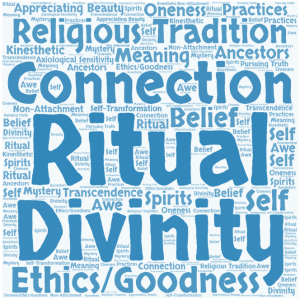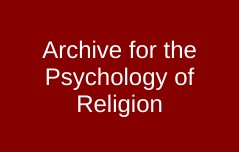Sociologists once thought that secularization and the end of religious commitment was inevitable, but this has not proven to be the case (at least not yet, in most parts of the world). While mainstream religions continue to thrive over most of the planet, quantitative research reveals that an increasing number of individuals self-identify as “spiritual but not religious.” But how do people understand the differences between religion and spirituality? And what are the different ways of being spiritual in the 21st century?
Approach

The Dimensions of Spirituality Project has designed a new survey instrument that helps researchers examine the wider landscape of spirituality in its many variations. The Dimensions of Spirituality Inventory (DSI), which is available online, demonstrates that “spirituality” is a complex but tractable term, opening up new possibilities for research.
The DSI team drew upon a wide reading of classic religious literatures, theories in sociology and psychology of religion, and previous qualitative sociological research indicating that there are several identifiable cultural “packages” of spirituality, such as theistic, ethical, belief-and-belonging, and so on. The result of integrating these sources is an instrument with five dimensions: Axiological Ideals concerns people’s sense of what is most important in life; Belief and Belonging examines how individuals relate to received religious beliefs, rituals, and traditions; Mystical focuses on experiences that resist comprehension or otherwise transcend the bounds of normal experience; Personal queries selfhood concepts, the individual’s orientation to the encompassing environment, and the sense of personal meaning and purpose; and Transcendent Beings highlights the role of beliefs about gods, ancestors, spirits, and other supernatural beings.

Typically, “spirituality” is either considered too complex and messy a term for scientific analysis or it is employed in an overly simplistic way to meet whatever passing needs a researcher may have. The DSI charts a middle path between these extremes, paying close attention to the intricate differences between individual spiritual profiles while also detecting underlying patterns of similarity to yield a useful instrument for future research. This approach has enabled the team to demonstrate that contemporary human spirituality is more dynamic and diverse than people might guess based on familiar religious services and also more structured than the word’s wildly diverse uses might suggest.
Impact
A pilot study using the DSI discovered five spiritual factors latent in the data: Morality-Based, Ritual-Based, Mystical, Kinesthetic, and Aesthetic. These results are currently being analyzed and will be submitted for publication in a journal covering the scientific study of religion. While the DSI needs further testing across a variety of settings, this early data indicates that it is a powerful and subtle tool for creating inventories of religious and spiritual identities that go beyond outdated binaries, such as “theistic” versus “non-theistic.” Through future testing in different cultural settings, the DSI might also help us discern what spirituality means to people in a variety of cultures and how they use words such as “spirituality” to navigate their worlds of meaning and forge their identities.
Understanding the kinds of personal and social structures that will dominate religion in the 21st century requires bold theorizing and careful empirical investigation. By asking the right questions, the DSI gives us a new lens to see the ever-changing tapestry being woven all around us, helping us to understand the ways people find and construct meaning and spiritual outlooks on life.
Latest updates

The Dimensions of Spirituality Inventory
Wesley J. Wildman, David Rohr, Steven J. Sandage, Nicholas C. Donato Archive for the Psychology of Religion Abstract: The Dimensions of Spirituality Inventory (DSI) is a 50-item quantitative assessment of spirituality. Whereas “spirituality” has seemed to some to be too…

